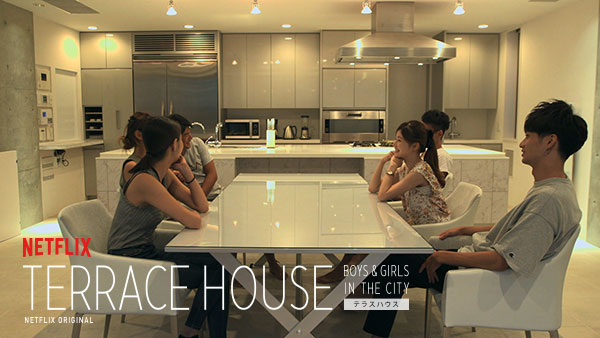"as long as one enters cross-demographic communication with a guiding 'thesis' (influenced by one's own cultural location), the emerging 'synthesis' will necessarily be dependent. Moreover, as comparative studies in East-West discourse have demonstrated, the 'antithesis' will always be described, inscribed, and/or judged in terms of the theories and practices of the guiding 'thesis' and through the cultural location of the interpreting scholar, producer, or viewer" (146)I want to look at an example of this type of comparative discourse, which exists not only in television scholarship but popular journalism about television as well. My first thought as an example was the Japanese reality television program Terrace House (which I literally cannot stop watching the last week or two and it is beginning to ruin my life). Terrace House ran for eight seasons in Japan from 2012-2014, a movie was produced to end the show and then in 2015 the show was picked up by Netflix in collaboration with Fuji Television. Now the show has had two separate iterations on Netflix: two seasons in Tokyo and two seasons in Hawaii. The show features six twenty-something strangers, brought together in a sumptuous house with a pool and a car provided for them. Sound familiar? Some American journalists thought so.
Articles like this one in Wired Magazine make the easy comparison between Terrace House and The Real World -- but to make this comparison based on the premise of the show is to miss the real and profound differences between the two, cultural differences that make Terrace House soothing somehow whereas The Real World gives me a migraine. A Polygon article makes the argument that the reason Terrace House is so compelling to Western viewers is because it is more 'real' than our versions of 'reality' TV:
I want to argue here that the interpretations of Terrace House as, in the case of the Polygon article, "fixing what's broken in reality TV" essentially begins with a Western framework of what constitutes reality television and more broadly, what constitutes the real or the authentic. Terrace House may be, in comparison with Western reality shows, soothing in its calm disagreements over dishes or worries about whether holding hands is moving too fast. However, taken in its own media and cultural ecosystem, Kumar's thesis-antithesis-synthesis argument makes me wonder if Terrace House may be a totally different kind of show - one not thought of as a Japanese version of American reality television but instead as a well-loved addition to a different genre or watching practice altogether. In comparing Terrace House to The Real World, we must lose much of the cultural nuance and media positioning that contextualize the show in Japan. What does it mean to argue that Terrace House lets participants "simply...be"? How does the sense of producerlessness translated to the American viewer play with Japanese audiences?"It’s hard for even a casual fan of American reality TV to deny that, to a show, the “reality” feels painfully scripted. Participants are coached in how they react to certain situations, edits are made to keep conflict and drama at their absolute maximum.It’s impossible for me to know how Terrace House is produced, but my sense is that ... it isn’t. Or rather, the producers seem to keep their interference to a minimum, and allow the “conflict” and “drama” to simply ... be."
If, as the Wired article argues (and this piece is really worth a read, gesturing more broadly to Netflix's global ambitions and its move into local television in multiple countries), shows like Terrace House are the future of Netflix, and "as Netflix becomes available in most parts of the world, all of the TV already being made around the world has the potential to find its way onto to Netflix and into my apartment. When it does, global TV could start to look a lot less like the Americanization of global entertainment and more like a cultural exchange", then globalization is beginning to really resist the imperialist model discussed in the reading. As it does so, and as American audience begin to consume more and more non-Western television, it will be more important to understand these shows not merely as iterations of current American television (which is the easy way to describe show premise or content) and not merely as a form of cultural tourism, but instead as media objects with their own cultural and industry contexts.

No comments:
Post a Comment